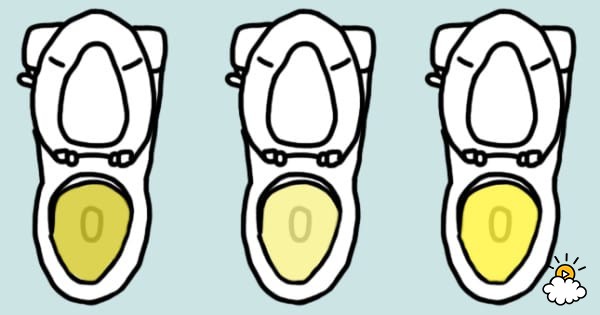We often find it awkward to talk about our bodies.
However, it’s crucial to ask questions about conditions that are causing you pain and discomfort. For example, the shape and color of your stool can reveal tons about your health.
Similarly, the color and consistency of your urine can alert you to certain deficiencies and disorders your body might be dealing with.
In an exclusive guide below, we’ll outline several dangerous signs you can spot in your urine.
Not only can we study substances like protein, sugar, yeast, and bacteria by looking at urine, but we can also use it to detect severe issues, like cancerous tumors and bladder infections.
And though many try to soothe their symptoms with medicine and supplements, it’s still so important to consult your doctor for further instructions.
Scroll further to learn how you can spot crucial signs in your own urine, and let us know your thoughts in the comments below!
Know How To Identify Healthy-Looking Urine
It’s crucial to first know what normal, healthy urine looks like. According to experts at the Cleveland Clinic, any color within this range is perfectly fine:
Dark yellow and transparent
Pale yellow and transparent
Yellow and transparent
Usually, if your pee has a lighter color, it means you’re in excellent condition: you’re well-hydrated, and you urinate pretty frequently.
But there’s no need to worry if the color of your urine falls on a darker shade of yellow. This just means that you might need to drink more water, but other than that, you’re perfectly normal.
Many external factors influence the color of your urine: medications, chemotherapy drugs, laxatives, and dyes found in certain foods.
Take a look at the following urine colors to find out the condition of your body, from your bladder and kidneys to your blood.
1. Amber- Or Honey-Colored
When the color of your pee borders on the darker side, this means your body is slightly dehydrated.
While easily remedied, you should pay closer attention to your water intake, and not let it become a bad habit.
You should also know that urine is there to rid your body of toxins. So if you hold your pee in for long periods of time, or if you don’t drink enough water in order to urinate frequently, toxins will more easily build up in your body.
2. Transparent
It might seem contradictory, but there is such a thing as consuming too much water.
Drink a good amount to stay properly hydrated, but don’t overdo it so that your urine becomes completely colorless.
This means you’re overhydrated — and that could lead to a series of complications.
Your kidneys may not be able to work fast enough to process the urine out of your body, causing way too much water to collect in your system.
And when your body retains too much water, it can cause an imbalance between water and sodium in your blood.
3. Brown- Or Syrup-Colored
If the color of your urine looks similar to that of Coca-Cola, your body may either be severely dehydrated, or be dealing with a host of other issues.
Brown urine can be caused by eating certain foods, like huge quantities of fava beans, rhubarb, or aloe, according to the Mayo Clinic.
But taking medication like antimalarial drugs, certain antibiotics, laxatives, and muscle relaxants can also result in dark brown urine.
Be sure to consult your doctor if this persists, as you want to rule out conditions like urinary tract infections, and liver and kidney disorders.
4. Foaming Or Fizzing
Definitely don’t be alarmed if you see a little foam or fizz in your urine. This can happen when you urinate faster than usual.
However, if the foam persists, see a doctor. It may indicate a rather high level of protein in your diet, or a serious problem with your kidneys, according to the Mayo Clinic.
5. Pink Or Reddish
Pink or reddish urine may indicate a wide variety of issues.
While it may simply be caused by something you ate — like great quantities of beets, blackberries, or rhubarb — you could also be dealing with serious medical conditions, like urinary tract infections, kidney diseases, cancerous tumors, and even prostate problems.
Again, medications such as chemotherapy drugs, laxatives, and antibiotics used to treat tuberculosis can all turn urine a reddish-orange color.
6. Orange
Like pink and reddish urine, orange-hued urine can result from an assortment of causes.
You could be dealing with certain medical conditions, such as an issue with the liver or bile duct. Check to see if you have really light-colored stools, as it may be closely tied to similar conditions.
Of course, dehydration can also cause a concentrated, deep orange color in urine.
7. Blue Or Green
Green or blueish urine can be caused by a genetic condition called “hypercalcemia,” a rare inherited disorder that even affects babies and infants.
Usually, urine of this color results from dyes and food coloring. Dyes used in some kidney and bladder function tests can also turn urine blue.
But if you continue to have brightly colored urine like this, get checked up to rule out things like bacteria or a urinary tract infection.
8. Cloudy Or Murky
Most commonly, urinary tract infections and kidney stones can cause urine to look murky and cloudy.
Food can also possibly change the consistency of your urine. Other times, tiny amounts of blood in urine can appear in a cloudy form, rather than completely red in color.
Other bladder infections, like cystitis, can cause painful and frequent urination, in addition to murky urine.
Also keep in mind that cloudy urine during pregnancy is pretty common. Pregnant women may often experience an increase in vaginal discharge, which mixes with urine to create a murky appearance.
Fuente: www.littlethings.com
